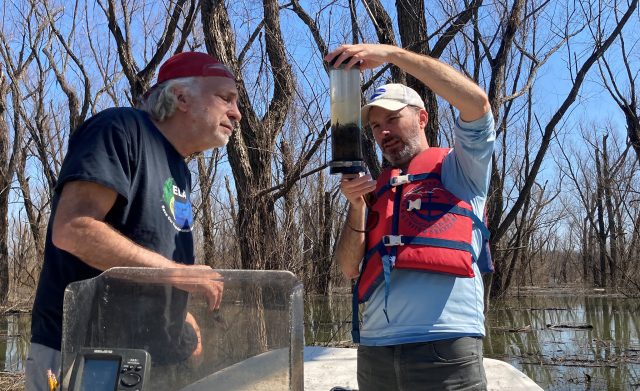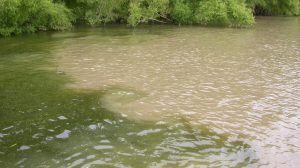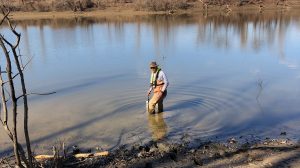
UM biology professor Cliff Ochs (left) and Jason Taylor, research ecologist at the National Sedimentation Laboratory, examine a tube of sediments from the bottom of Desoto Lake in April. The lake is in the Mississippi River floodplain, and the research team uses these samples to measure nitrogen cycling in the floodplain. Photo by Doug Shields Jr./Shields Engineering
OXFORD, Miss. – A University of Mississippi biologist is working to understand how the Mississippi River’s floodplain lakes and wetlands, or “backwaters,” might help remove nutrients that contribute to Gulf of Mexico hypoxia, or as it’s more commonly known, the “Dead Zone.”
With funding from the U.S. Army Corps of Engineers, biology professor Cliff Ochs and his research team will evaluate the role that backwater lakes and wetlands in the Mississippi River floodplain play in removal of nutrients and production of algae. They also will create a computer model that helps to determine the controlling factors for these processes.
Gulf hypoxia occurs when an excess of nutrients – namely nitrogen and phosphorus – are carried down the river into the Gulf of Mexico. This is mainly the result of runoff from the landscape, including fertilizers and wastewater, getting into the river and its many tributaries.
When these nutrients flow into the Gulf, they promote the growth of large amounts of microscopic algae, called phytoplankton, which eventually sink into deeper water and decompose. The bacteria that decompose the algae deplete the water of oxygen.

Lake water (left), rich in green algae, mixes with brown river water in a Mississippi River backwater. This interaction illustrates the differences in biological production of the two types of habitats. Submitted photo
“Gulf hypoxia is harmful to lots of living things that live in the deep water of the Gulf,” said Ochs, the project’s senior investigator. “It especially affects invertebrate organisms like shellfish; they can’t easily move out of the hypoxic zone.
“Many fish feed upon these invertebrates and they also support commercial fishing.”
The Mississippi River can go up and down in elevation by nearly 50 feet in a year. In the springtime, when it is high, river water flows into the floodplain. The project’s main hypothesis is that when river water rich with nutrients gets into lakes and wetlands off the main channel, these backwater sites can help eliminate the nutrients from the system.
While these biological processes remove only a fraction of the excess nutrients that the river transports, it is possible they could be managed and combined with other measures to help combat hypoxia. The research seeks to determine over what area of the floodplain these processes occur, at what times and exactly what factors drive the rates at which these processes occur.
Ochs said he believes that backwater sites are important to nutrient removal because their physical conditions are so different from the river’s main channel.
“The river itself is a big, turbulent, deep and dark flow of water,” he said. “There really isn’t much opportunity in the main channel for nutrient removal by biological activity. But in the floodplain, the situation is different.
“The sites that we are working on in the floodplain are lakes and wetlands where the water tends to stop moving so fast, clears up and then settles into layers or ‘stratifies.’ These lake conditions promote lots of biological activity and growth that are not possible in the main channel of the river, and that help contribute to nutrient removal, also known as ‘nutrient sequestration.'”

Doug Shields Jr. installs water level recorders at a sample site in the Mississippi River floodplain. Shields is part of a research team led by UM biology professor Cliff Ochs that is studying how floodplain lakes and wetlands help remove excess nutrients from the Mississippi River. Submitted photo
Ochs’s principal collaborator is Doug Shields Jr., a consulting hydraulic engineer at Shields Engineering at the UM Insight Park.
“I was really excited for the opportunity to do research on the Mississippi River with Dr. Ochs,” said Shields, who is retired from the USDA National Sedimentation Laboratory and serves as an adjunct professor for the university. “Although my academic training is in civil engineering, my main focus has been river ecosystem restoration.
“As a team, (Ochs) is the life scientist and I focus on the physical processes such as the movement of water. We speak a common language and we’re able to complement each other’s talents.”
Along with a series of students, Ochs has conducted ecological research on the Mississippi River for about 17 years.
“We were obtaining a lot of data about the biological and chemical processes in the river and the floodplain,” he said. “When I saw how biologically productive the lakes were, I started wondering whether they could be important in nutrient removal.
“Based on the data we had already acquired, I thought maybe we could create a computer model to help us evaluate the role these floodplain sites may or could have in nutrient sequestration. So I got together with Doug Shields because I knew he had the interest and chops to help do that.”
Working with data supplied by Ochs, Shields created such a model. The simple simulation predicted the amount of nutrients that, depending on the height of the river and interaction with the floodplain, a given floodplain lake could remove from the main channel.

The majestic Mississippi River picks up a load of nutrients on its way to the Gulf of Mexico. Researchers are studying whether backwater lakes and wetlands help remove some of these nutrients, and how this may help avoid dead zones forming in the Gulf. Submitted photo
This caught the eye of the U.S. Army Corps of Engineers. After publishing a paper in River Research and Applications, Ochs and Shields were approached by the corps to submit a proposal for funding to expand the project. The project, “Modeling Relationships Among Lower Mississippi River Backwaters Hydromorphology and Biogeochemical and Ecological Processes,” is in its second year of support.
“Our initial model was based on a limited amount of data, and fairly basic,” Ochs said. “We are trying to improve the model to make it as accurate and predictive as it can be for at least a small portion of the river.
“If we can get a good handle on how this interaction works with respect to nutrient sequestration, then perhaps we can extrapolate from that small section to a bigger section.”
Jason Taylor, research ecologist at the National Sedimentation Laboratory, and Padmanava Dash, associate professor in the Department of Geosciences at Mississippi State University, are also collaborating in the research.
Shields said he hopes that the work will ultimately provide a basis for a deeper appreciation of river backwater sites and their services, and managing them so that they are protected.
“We may even be able to optimize conditions to accentuate the positives that these ecosystem services provide,” he said. “There are a lot of big rivers around the world that don’t have much interaction with backwaters anymore because humans have modified the channel and floodplain.
“The lower Mississippi River is a great national treasure in that regard because it still has significant backwaters. If we’re not careful, they will all be gone. We need to manage them for future generations.”